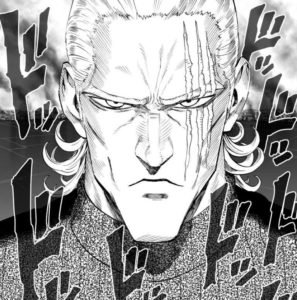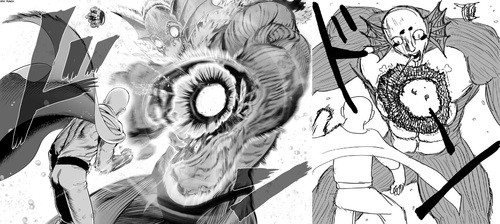One Punch Man
Self-Published/Shueisha/Viz Media, 2009-present
Author: One
“One-Punch Man” originally started in 2009 as a shonen parody webcomic by an author working under the pseudonym “One.” The webcomic employs a crude amateurish art style that fits in perfectly with the tone of the story. The plot revolves around a mysterious hero named “Saitama” and his exploits in the fictional metropolis called City Z.
A digital manga remake of the webcomic began publication on Shueisha’s “Young Jump Web Comics” website in 2012, featuring an updated art style by Yusuke Murata. The digital manga remake was eventually licensed by Viz Media for an English serialization, and has begun publication on their Weekly Shonen Jump digital magazine.
In “One-Punch Man”, Saitama is implied to be the strongest being in the story’s fictional world, being overpowered to the point that he can end all fights with a single punch (hence the name). However, Saitama is paradoxically languishing in relative obscurity and considered by most of his fictional colleagues as a low ranking superhero.
The story works on the surface level as consisting mostly of elements cobbled together from the shonen genre. The series’ roots as a webcomic is easily discernable by the presence of throwaway jokes that are set up and executed within a few panels. Visual gags are also employed effectively, which is why the digital manga remake is more effective – the dour visuals contrast with juvenile humor in subtle ways, whereas the webcomic’s intentionally roughshod illustrations tend to oversell the jokes (and sometimes detract from the story.)
However, underneath all the humor is a solidly constructed tale that can be appreciated on its own merits. The author relies on common shonen stereotypes (brooding powerhouses, naïve yet virtuous protagonist, a wise and elderly martial arts master, petite girls with powerful magic abilities, effeminate men with exceptional martial arts skills, and so on). But all of these key players have their place within the story. Most of the recurring characters are fleshed out and given backstories (except for those who are intentionally not given backstories, inevitably as a joke.)
There is effort given to outlining the dynamics of the superhero scene, by relying on a bureaucratic caste system where heroes are assigned ranks. This is taken to ridiculous extremes as the heroes themselves use it to oppress, denigrate or dismiss colleagues. On the one hand, it spoofs the concept of power levels made famous by shonen manga franchises like Dragon Ball Z and Yu Yu Hakusho, but on the other hand, it also subtly mocks people’s over reliance on image, status and fame when measuring a person’s worth.
In some ways these backstories overlap each other and provide much-needed texture to the narrative. For instance, one of the recurring characters called “King” is the mirror reflection of protagonist Saitama in the sense that he is recognized by the public as the strongest and most dangerous hero in the world, yet he is actually a powerless and cowardly “otaku” who only gained his reputation by constantly being in the right place at the right time – most of the achievements credited to him are actually the work of Saitama.
In the story, King is constantly beset by dangerous assassins and vengeful villains. These assailants are regularly dispatched by Saitama, usually through coincidence. It is revealed in one of the one-shots that Saitama and King are actually videogame rivals, regularly meeting in secret in order to play against each other.

The Strongest Man on Earth, S-Class Rank 7 Hero: KING.
“One Punch Man” does a good job at world building, although the genre and its inherent macrography obviously provides the freedom to do that. The series is also a great read for people who enjoy action scenes. The story is filled to the brim with flashy action set pieces: various fighters employ unique and contrasting disciplines and abilities. The fight scenes are exactly what an aficionado of shonen expects from a series that borrows heavily from popular shonen franchises. And this is where the updated visuals of the digital manga remake start to edge out the original webcomic – Yusuke Murata’s art makes the hyper kinetic panels a joy to look at, whereas One’s doodles tend to detract from what’s going on.

L: digital remake, R: original webcomic
We highly recommend One Punch Man to readers who enjoy comedy and the young boy-focused shonen genre, but we lean more towards the digital manga remake as a starting point, with the original webcomic relegated to being mere novelty.



